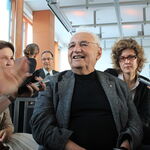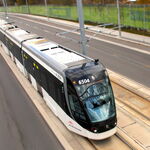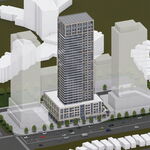YRT's problem too is they are "increasing" every route from a 27 to 24 minute frequency, which functionally isn't much of an improvement.. over just picking a few high performing routes and bringing them to actual service levels. Start with maybe 3 or 4 routes and give them 10-15 minute frequencies throughout the day.. then work on bringing the other routes up to that, don't just slowly bring down every route's frequency by a minute or two every year, which doesn't deliver substantial benefits or build ridership as effectively.
YRT's service levels continue to absolutely baffle me for what is a relatively dense region with a huge employment base. It makes no sense, and I think speaks more to mismanagement from politicians and service planners than it does to anything to do with urban form, density, or demographics.
Yes. Durham Region has become the new rising star in the GTHA, as Brampton's service growth has slowed in the last few years before the pandemic hit. Some of the stuff DRT is doing lately, even despite COVID, is really good.
What DRT has done with axing low demand routes, replacing them with on-demand service, then reallocating that service to key routes, is a pretty good idea - better to have a few functional routes than many nonfunctional ones.
I think what Durham has done has to do with how Durham is laid out - it's quite long east to west, but fairly narrow north to south, so very few north-south routes are viable, even north-south arterials.
This actually translates really well to Northern York Region - it's very narrow east to west, but long north to south. Yonge, Bayview, and maybe Bathurst are viable routes, but there are pretty much no viable east-west routes, since they are all too short and don't hit enough important destinations. The result is that almost all routes north of Elgin Mills are either short stub routes or circling neighborhood type routes to nowhere.
Basically all of these perform terribly and many have been suspended for COVID, but honestly I think most of these routes should just get permanently replaced with on-demand, with resources poured into core routes. Same goes for a lot of the other neighborhood routes in southern York too - it seems like YRT likes to try and fill the gaps between arterials, but the reality is with 40min service and circuitous routing it's probably faster to walk or bike to the arterial in most cases. Even TTC doesn't try to fill the gap between every arterial when there are no straight roads and no large apartments to serve.
Here's a list of routes I would ax or truncate in order to improve core routes:
- 87 could be axed
- 23 truncated to RHC instead of Finch
- 82 can probably just be axed, it performs really poorly and doesn't hit any major nodes
- 3 can probably get axed or truncated to between Promenade and Leslie
- 83A can probably get axed
- 40 and 41 completely reworked to reduce one-way loops and shorten/simplify routing
etc. (I could keep going)
Finally, YRT really needs to integrate with GO better, especially the Barrie and Stouffville lines. For some reason YRT seems like the only 905 agency to have this problem. It's crazy how Viva Purple just goes straight past Unionville GO without stopping, or how Viva Yellow stops like 150m away from Newmarket GO, or how so many routes decide to just pass by a GO station without entering it, including some already horribly circuitous routes (e.g. 41 at Markham GO, 40 and 41 at Centennial GO, 32/33A at Aurora GO).




